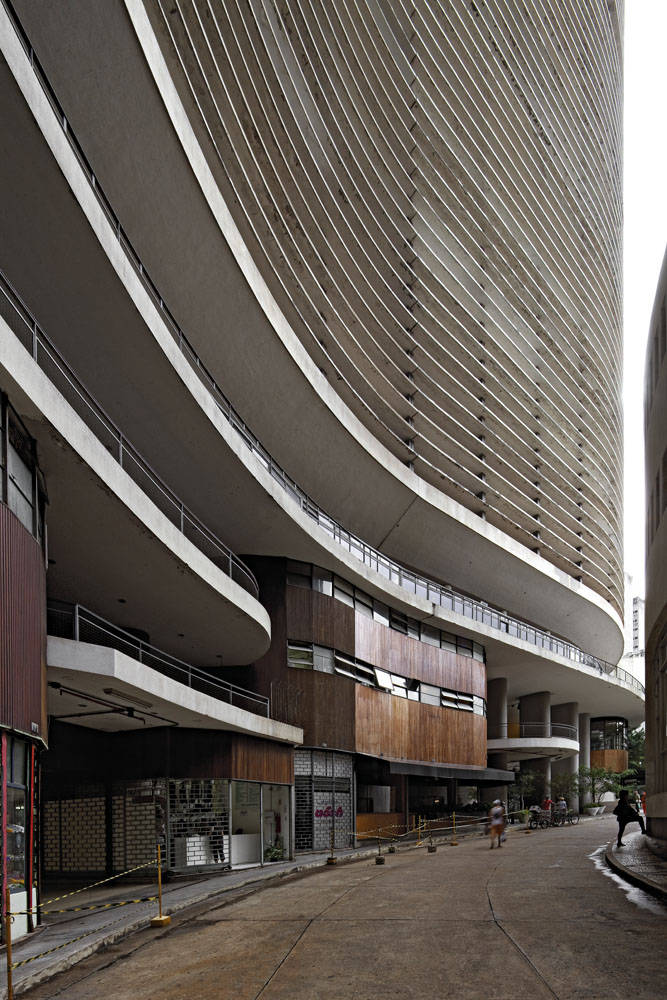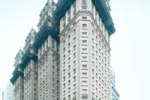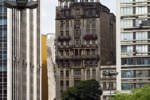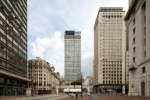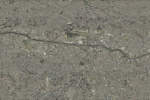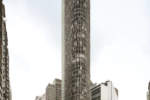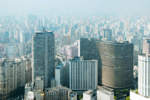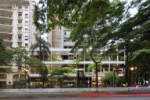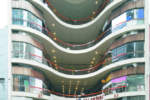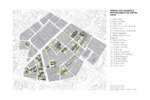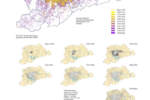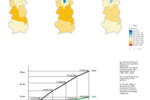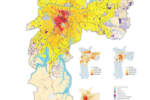To realize itself, Brazil needs lyrism, an ability to forget itself, and as to virtues, an ability to surpass itself. Its modern architecture is a masterly lesson of these two redeeming requirements.
Anísio Teixeira (Brazilian pedagogue, 1900 -1971)
In his collection of photographic documents on São Paulo (referring to the period between 1935 and 1937), Claude Lévi-Strauss warned against the futility of a nostalgic attitude to everything that can no longer be found in the present moment, evoking that feeling that wrings our heart in the moment when, on remembering or seeing certain places, we are overwhelmed by evidence of the fact that there is nothing stable or permanent to hold onto in the world. Such a feeling of general inevitability may have been instilled in the great anthropologist by the excessive mutation and transformation of the self-same city of São Paulo, a metropolis which has in other contexts been called “the city with the world’s highest growth rate”. The scholar can only find this reality again in the images kept in his memory and in photographs. In fact, the statistics which describe this process are impressive: in 1872 São Paulo had 31,385 inhabitants, while in 1890, after slavery had been abolished and the coffee economy began to yield its fruits, its inhabitants grew to 64,934. In 1900, on the eve of the republican period, the city already counted 239,820 inhabitants; twenty years later, with the first glimmers of the cultural modernity, it arrived at 579,033, and from 1940 to 1950 the number almost doubled, increasing from 1,326,261 to 2,198,096. The city today counts 11,244,369 residents and is the capital of a metropolitan region with about 20 million inhabitants. Three centuries have passed between the foundation of São Paulo and the city we today recognize as urban manifestation. It is a matter of a reality which has its origin in a demographic influx attributable to a social, economic and politic trend caused by a number of factors, as the production of coffee for exportation, the end of slavery and monarchy, the launching of national industrialization and an unprecedented immigration. All this has led to the creation of a complex society. These events, which succeeded one another between the late 19th century and the first decades of the 20th, are reflected by a singular and extraordinary mode of urban expansion: we may assert that transformation is the distinctive trait of São Paulo because, while it grew horizontally, the city was being rebuilt on the self-same urban tissue. In one of his studies on the city Benedito Lima de Toledo presents a succession of techniques utilized in the construction of local buildings: the original city with walls in pisè (damp mud) has been replaced by a city with walls in terracotta and then by a city in concrete. And all this has happened in the course of a single century. If we relate the significant demographic growth to the manner in which the different ethnic groups have settled in this region, triggering a process of mutual contamination of usages and costumes while maintaining their own systems of values and their own forms of urban occupation, we can elaborate an idea of a city which escapes those who approach it as simple visitors. On the eve of its demographic growth, São Paulo became home to ethnic groups coming from many regions of Brazil and the rest of the world. This was to give rise to a social custom that soon became widespread: each group tended to define its identity by a constant process of acknowledgement of mutual affinities and divergences, associating their own behaviours and ways of being with their respective geographic and cultural origins. One frequently encounters analyses of such issues in chronicles and literary works from the period, which substantiated labelling, stigmatizing and prejudices, but also privileged signs of identity. In a city whose historical genesis has been characterized by domestic and foreign migratory flows, explosive urbanization and demographic growth, and that has represented a melting pot of costumes coexisting in the same space, the study of the assiduous presence of representations of various “foreign” identities represents an attempt to understand the singular relationship which has developed between culture and urban space. São Paulo can be seen as a mosaic of memories of other places which each immigrant or social group has brought with it, as its own distinctive idea of city or urbanity. Memories of other places and memories of what has by now been destroyed provide the lifeblood of a city which, while being concrete, is also representation of other cities and cultures. Some social groups, required to live in a city that keeps renewing itself, have sought their own exclusive places of self-recognition. However, considering the urban dynamics, the very idea of permanence and identification with the urban space could not be lasting, especially for the working classes, which are very vulnerable to the process of removal from an urban tissue. What has been created in São Paulo is therefore a popular kind of cosmopolitanism, where the fact of sharing experiences has made it possible to escape from the pain of exile within the great metropolis. Familiarity with the experiences of the other, the foreigner, has also represented a means of identifying with the same (and always adverse) conditions. When the city began to grow vertically in the Twenties, the process of demolition and reconstruction was intensified. The city’s first “skyscraper”, the Sampaio Moreira building (1913-1924), designed in reinforced concrete by the architect Cristiano Stockler das Neves, featured 13 floors and a height of 50 m. The Martinelli building, erected between 1925 and 1929, with its 25 floors and a total area of 46,123 m2, is the symbol of this new era. Both buildings are still in perfect conditions, and are in this sense an exception to the rule of continuous transformation. According to Aldo Rossi, things that remain represent a past that continues to live. We might add that it is a matter of a past that keeps offering us lessons in urbanity that are never out of date. The historical density of a building cannot be reduced merely to its age, but is measured on the basis of its ability to stay up to date, to build a qualitative relationship with time: in other words, rather than being consumed, a building stays contemporary. Some isolated experiences of modern buildings in downtown São Paulo, most of them from the Fifties, have confirmed this extended interpretation of permanence, because they have led, from an overall perspective, to the realization of an urban subsystem, located in the so-called Centro Novo: a newer district built to the west of the original city centre, which may be identified as the area enclosed between the valley of the Anhangabaú river, the Avenida São João, the Avenida Ipiranga (and the adjacent to Praça da República), the Avenida Consolação, the Rua Xavier de Toledo and Praça Ramos. It is in this area that the most important historical buildings from the heyday of the coffee economy - the late 19th century – are found, together with the most important modernistic skyscrapers from the middle of the Twentieth century.
Among the latter we may distinguish the category of so-called city buildings, aggregates that promote relations characteristic of an urban context, implemented by the variegated functions (commercial activities, services and dwellings) and the proposal of morphologies creating new pedestrian routes that are superimposed on the existing street network. Within this perimeter there are at least twenty buildings (the Eiffel building, the Copan building, the Itália building, the Conde Silvio Penteado building, the Louvre building, the Conjunto Zarvos e Ambassador, the Galeria Metrópole, the Esther and Arthur Nogueira buildings, Galeria Califórnia, Galeria Louzã, Galeria das Artes, Galeria 7 de Abril, Galeria Ipê, Galeria Nova Barão, Galerias Itá e R. Monteiro, Galeria Guatapará, Grandes Galerias, Conjunto Presidente, Galeria Olido and Galeria Apolo) built with arcades that offer transit routes and host services and commercial activities on ground level.
It is a matter of true alleys created inside the private buildings, connected to streets accessible to the public and to other such arcades, that offer alternative pedestrian itineraries and create a rich web of interrelations between the city and the architecture. The Copan building (1951) designed by Oscar Niemeyer, and the Galeria Metrópole (1959) designed by Salvador Candia and Giancarlo Gasperini are two significant examples of this category; after a period of neglect and dilapidation they are now being renovated, and will be able to demonstrate their respective potentials in terms of keeping abreast with the times and of giving lessons in urbanity to a metropolis that strives to be always new. The Copan building is one of the symbols of the cityscape of São Paulo. Its volume, its single, curvilinear body articulated in a structure with horizontal blades that serve as sunscreens, contains 1600 apartments and about 5000 residents on 30 floors, and features a differentiated morphology characterized by a generous permeability: its slightly inclined corridors adapt to the land, adjusting to the level of the streets in the neighbourhood. The Galeria Metrópole is a 23-floor tower housing offices, placed on a 5-floor structure designed as if it were an urban block with a vertical arrangement: an open internal garden (almost a square) surrounded by shops with display windows and a movie theatre (today in disuse). The Galeria Metrópole, which faces the Avenida São Luiz and the Praça D. José Gaspar (which hosts the Mário de Andrade Library) on one side, also features an entrance point in the Rua Basílio da Gama, which communicates with the Praça da República. The two buildings thus serve as a centre of confluence and irradiation of pedestrian paths. One may reach the Galeria Metrópole from the Copan building by passing below the Edifício Conde Silvio Penteado and crossing the Avenida São Luiz. Even if it is short, this path is emblematic for purposes of what we want to show here: the introduction of modern architecture and town planning principles in the city of São Paulo has taken place in a consolidated urban context, something which has called for the creation of an interdependency between town planning and architecture on the basis of existing elements. To describe the genealogy of such buildings, it is not sufficient to highlight the previous solutions that have served as frame of reference to appreciate their urban values. These values may be understood if the study of the architecture is not limited to the isolated case, but recognizes the synergic and urban dimension that an aggregate of buildings have succeeded in creating. And we are surprised that these actions have not been previously coordinated, but have developed in isolated contexts, on the basis of an urban vision. The Centro Novo has not only been an extension of the old town; it has represented both a new urban model, aimed at expressing an invitation to live together precisely in the streets understood as the setting for an active social life, and the moment in the process of metropolization of São Paulo characterized by the greatest attention to its own peculiar cosmopolitan valence. It is a matter of solutions that assert their topicality and contemporary nature by virtue of their opposing the predominant models of exclusion and segregation.
Luís Antônio Jorge Arquiteto e urbanista Professor Doutor da Faculdade de Arquitetura e Urbanismo da Universidade de São Paulo. Coordenador da Área “Projeto, Espaço e Cultura” do Programa de Pós-Graduação da FAU/USP.


